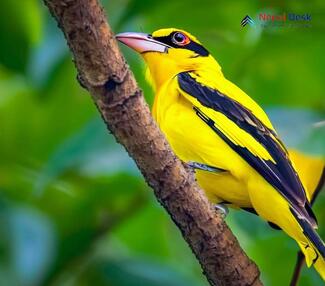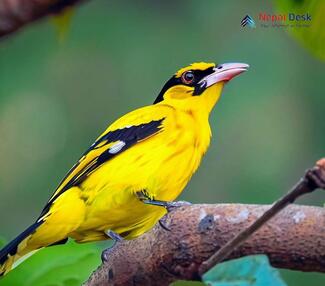Nepal, a natural paradise blessed with incredible biodiversity, is home to more than 800 bird species. Among these feathered beauties, the Black-naped Oriole, Oriolus chinensis stands out for its vibrant yellow and black plumage. This stunning bird captures the hearts of both ornithologists and casual birdwatchers alike. Join us as we dive into an in-depth analysis of this striking bird native to Nepal.
An Introduction to the Black-Naped Oriole
The Black-naped Oriole is a medium-sized passerine bird belonging to the family Oriolidae. Known for their distinctive call, these birds are often heard before they are seen. They are characterized by a vibrant yellow body, black nape (the back part of their neck), and black eye markings extending from the beak. Males boast a slightly larger size and thicker black nape compared to their female counterparts.
Understanding Their Habitat and Distribution
Black-naped Orioles inhabit a diverse range of environments within Nepal, including dense forests, open woodlands, and cultivated areas such as farms and orchards. Primarily found at elevations between 1500 and 2500 meters, they are particularly prevalent in the subtropical broadleaf evergreen forests found in the country's mid-altitude zones.
These birds have adapted well to human disturbance and can also be spotted in rural villages or urban gardens where fruit-bearing trees thrive. Aside from Nepal, the Black-naped Oriole can be found throughout Southeast Asia, Southern China, and India.
Feeding Habits
The Black-naped Oriole has a diverse diet which primarily consists of fruits, insects, nectar, and small vertebrates like lizards or small amphibians. During the breeding season when they must meet increased nutritional demands, they may also prey on other small birds' eggs or nestlings. These adaptable birds often forage both solitarily and in small groups, using their sharp beaks to extract fruits from trees or capture insects.
Breeding and Nesting Behavior
The breeding season of the Black-naped Oriole generally occurs between April and August in Nepal. During this time, male orioles display an elaborate courtship dance consisting of fluttering wings, spreading their tail feathers, and emitting melodious songs to attract a mate.
Once successfully mated, the female will build a shallow cup-shaped nest made of twigs, grass, and leaves high up in a tree. There, she will lay 2-3 pale bluish-green eggs with brown blotches. Both parents participate in incubating the eggs for approximately 14 days and feeding the hatchlings once they emerge.
Conservation Status
While not currently considered endangered or threatened, the Black-naped Oriole faces various challenges like habitat loss and illegal trapping for the pet trade. Efforts to conserve their native habitats and educate locals about the importance of preserving bird populations are essential to ensuring that future generations can continue admiring these colorful avian wonders.
In conclusion, Nepal's Black-naped Oriole, Oriolus chinensis is an enchanting bird that captivates nature lovers with its vibrant colors and melodious call. Let us all do our part in preserving these natural treasures by supporting habitat conservation efforts and fostering a deeper appreciation for the diverse species that call Nepal home.




